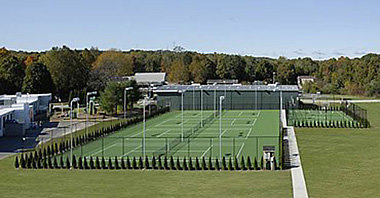Arias Tennis Wizard Five
Warm up, Stretch and Flexibility The Debate: Part I
 You already know that warming up before play is important. You
may perform a series of exercises with the objective of reducing
injuries and increasing performance.
You already know that warming up before play is important. You
may perform a series of exercises with the objective of reducing
injuries and increasing performance.
However, there is a body of current research regarding flexibility and stretching with some surprising results:
- greater static flexibility does not always decrease the risk of muscular injury;
- flexibility and stretching may be unrelated to injury risk;
- stretching has minimal effect of the stiffness of muscle, decreases muscular performance, and modifies the energy recovery of stretched muscle.
If you are like me, you might have said "WOW, that's the opposite of what I thought." For myself, I wanted to get clear definitions of warm up versus flexibility versus stretching and how this research impacts tennis players.
I went to two experts for the answers: Dr. Marc Safran, director of Sports Medicine at the University of California, San Francisco, orthopaedic surgeon and vice president of the Society for Tennis Medicine and Science and Dr. Duane Knudson, professor of exercise science at California State University, Chico. Dr. Knudson is a biomechanist as well as a member of the USTA sport science committee, and one of the individuals conducting this research.
Dr. Safran told me: "The warm up is an important means to prevent injuries and should be performed before every workout. The gradual increase of the body temperature through the warm up prepares the body for the hard work it has soon to perform. The elevated temperature increases muscle blood flow, mechanical efficiency of contraction, and the speed of nerve impulse, leading to more rapid and forceful muscle contractions. Also, the increase in temperature results in a decreased viscosity of muscle and a greater force and length of stretch necessary to tear a muscle. Thus, a proper warm up may reduce the incidence and likelihood of musculoskeletal injuries and lead to improved performance."
As well, Dr. Knudson has noted, "Most warm-ups should begin with general body movements of gradually increasing intensity, focusing on the muscles and joints to be used in training or competition... The American College of Sports Medicine recommends 5 to 10 minutes of calisthenic-type exercises and 5 to 10 minutes of progressive aerobic activity in warm-up. For example, tennis players may perform 5 minutes of light jogging, followed by the traditional 5-minute warm-up of groundstrokes and serves prior to a match... Warm-up may also decrease the occurrence of dangerous cardiac responses from sudden strenuous exercise in some people."
Good reasons to warm up! How does the recent research on stretching and flexibility fit into this? Knudson notes, "static stretching is not recommended during warm-up routines."
What's the difference then? Why wouldn't you want to stretch? Do most experts agree on this? What's the relationship between stretching, flexibility, warm-up, performance and injury?
Let's go through some definitions:
Warm-up: (Knudson) Warm-up consists of active or passive warming of body tissues in preparation for physical activity.
Active warm-up: (Knudson) Active warm-up consists of low intensity movements that are effective in warming tissue and producing a variety of improvements in physiological function.
Passive warm-up: (Knudson) Passive warm-up includes external heat sources like heating pads, whirlpools, or ultrasound.
Static stretching: (Safran) Static stretching is the most common form of stretching. This is where the muscle is slowly and gently stretched to the point of slight muscle discomfort and then held for a period of time (usually 10 - 20 seconds). This type of stretching is simple technique, has a low injury risk and does not require a partner.
Ballistic stretching: (Safran) In a ballistic stretch the muscle is stretched with repetitive bouncing motions. These exercises are generally not advised due to an increased risk of injury.
Active and passive stretching: (Safran) Combined active and passive stretching involves contraction of the muscle (without moving the joint), relaxation and static stretching of the muscle, in various combinations and orders. These techniques are capable of producing the greatest improvements in flexibility; however, they usually require the help of a partner. (These techniques may be useful for sports which require superior flexibility, such as gymnastics, but are rarely necessary in tennis.)
Flexibility: Flexibility is a property of body tissues which determines the range of motion achievable without injury at a joint or group of joints.
The issue then appears to be that recent studies question the correlation between stretching, flexibility, injury reduction and performance enhancement.
My thanks to my colleagues Dr. Marc Safran and Dr. Duane Knudson for their assistance in this interesting area of research.
I also wanted to thank all of you who responded to last month's "Can We Count" column. There were some great comments and I will be contacting some of you to ask if I can use your comments in a summary on the subject.
You can find more articles like this to help your tennis game by going to www.tennisserver.com .
Send your questions to the
< Previous | Return To Wizard Home | Next >
Programs

The SCJTL Summer Tennis League an inclusive “playing” experience for all junior tennis participants. Since 1997 the SCJTL Summer Tennis League has offered all participants the opportunity to play on teams on a league that emphasizes fun, fitness and friends.
Tennis Lessons
![]() Joe Arias is available for a full range of tennis lessons and personal coaching services. Private and group lessons for all ages and levels. Specialist in tennis biomechanics corrections and improvements, game style enhancement, singles and oubles training .
Joe Arias is available for a full range of tennis lessons and personal coaching services. Private and group lessons for all ages and levels. Specialist in tennis biomechanics corrections and improvements, game style enhancement, singles and oubles training .
Find Out More About Tennis Lessons
SCJTL Training Centers

The SCJTL Training Centers are learning and skill development facilities. Kids and adults learn and improve tennis skills thru SCJTL Personal Coaching Services and SCJT Player Development programs.
Find Out More About SCJTL Training Center
SCTEF
 Suffolk County Tennis and Education Foundation, Inc. (SCTEF) is a New York State, non profit corporation and Federal 501(c)(3) created in 2003, with the purpose of providing athletic, educational and charitable activities to all Suffolk County residents regardless of age, ability or socio-economic status.
Suffolk County Tennis and Education Foundation, Inc. (SCTEF) is a New York State, non profit corporation and Federal 501(c)(3) created in 2003, with the purpose of providing athletic, educational and charitable activities to all Suffolk County residents regardless of age, ability or socio-economic status.

